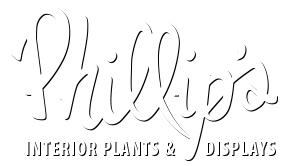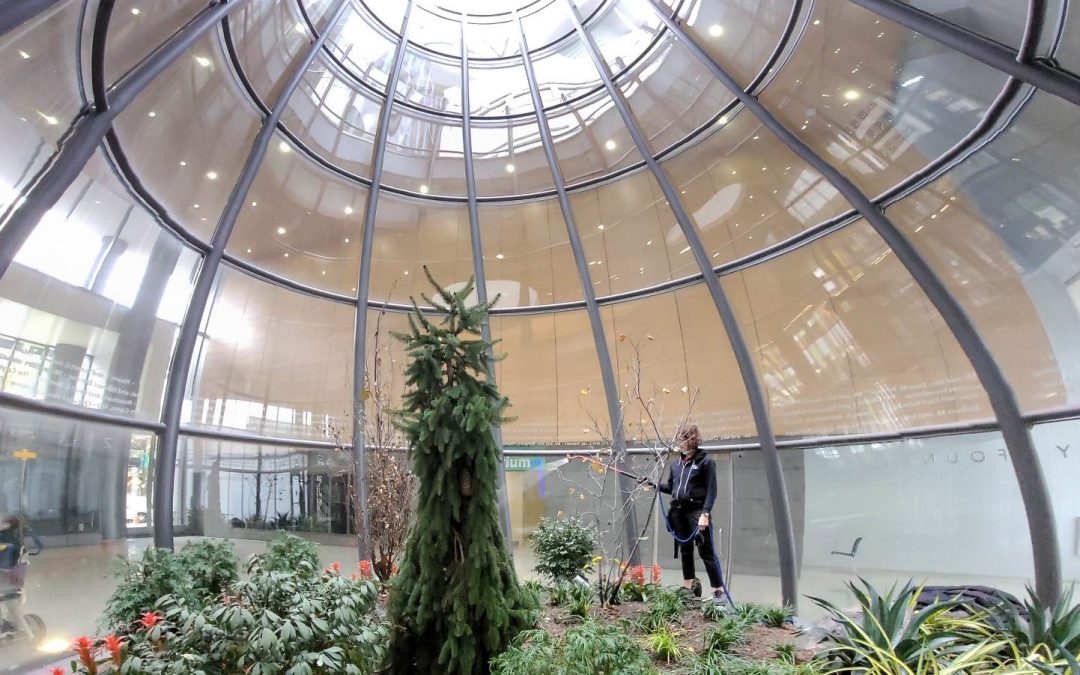The judges at the International Plantscape Awards, held earlier this year at the Tropical Plant International Expo, gave us a Platinum award for our submission in the Atrium category. The judges were impressed by our thoughtful redesign of this three-story open air terrarium.
THE PROJECT
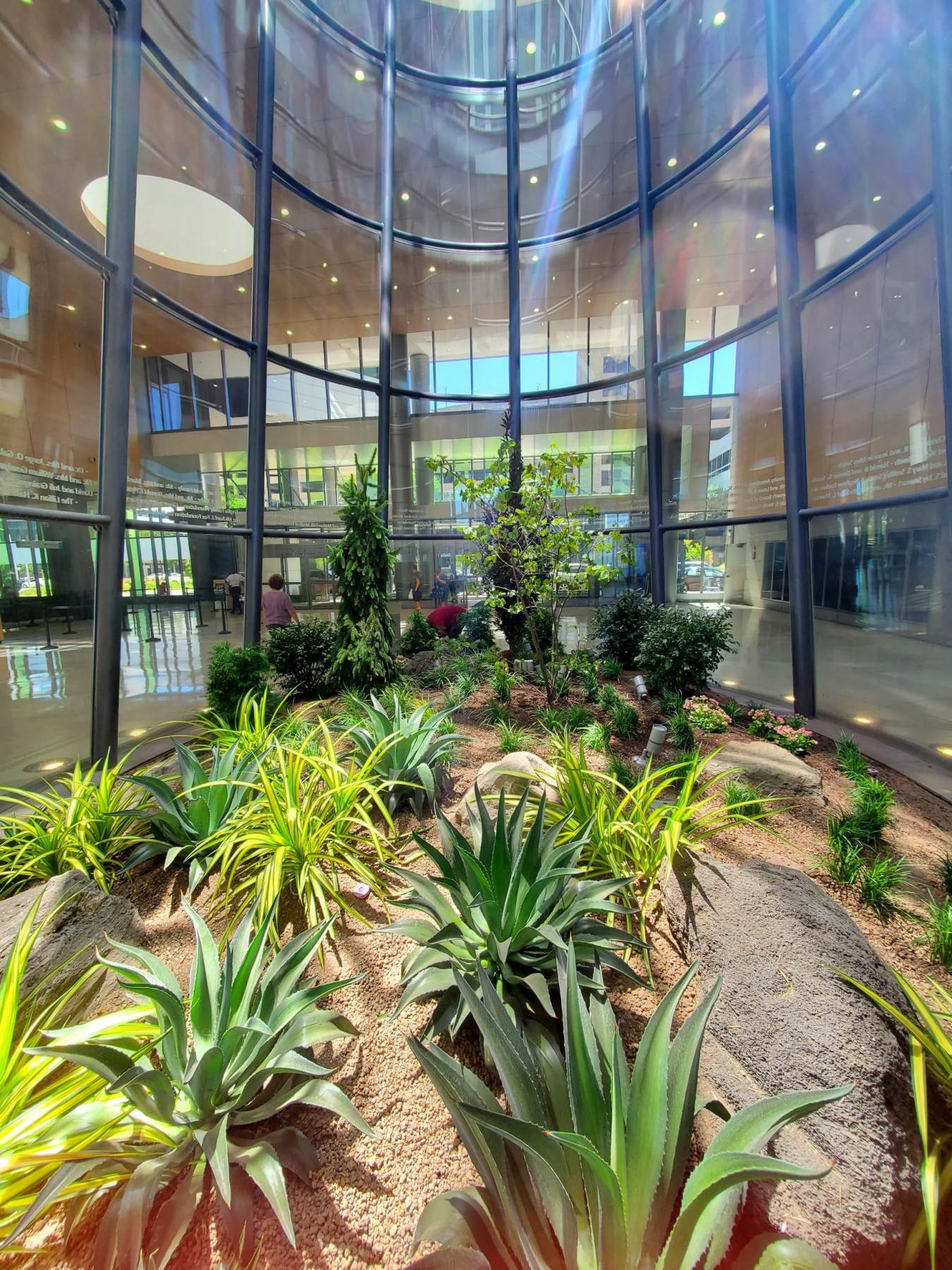
Category: Atrium and Garden Plantings
Project Address: Chicago, Illinois
Designed by: Shannon M.
Installed by: Shannon M. (Sales, Design, and Project Manager), Ron R. (Horticulture Installer), Lauren G. (Operations Manager), Craig R. (Horticulture Technician), Nate T. (Horticulture Installer)
Installation/Service Assumption Date: August 31, 2022
Dates Photos Taken: August 31, 2022; September 7, 2022; October 20, 2022
Project Name: Chicago Medical Facility Four-Season Terrarium
Project Description: Installation of exterior plants, shrubs, and trees within open to elements terrarium, along with seasonal blooming rotations.
Names and roles of firms and/or individuals to be recognized for their involvement on the project:
Phillip’s Interior Plants & Displays – Design, installation, and ongoing maintenance service
Phillip’s Interior Plants & Displays – Shannon M. (Sales, Design, and Project Manager), Claudia L. (Lead Horticulture Technician and Trainer, Assistant Blooms Buyer) – blooming rotation program selection
Chicago Foliage – supplied plant material
Fiore Nursery – supplied plant material
A Chicago medical facility reached out to our team in the Spring of 2022 to request that we bid on the renovation of their facility’s unique life-sized terrarium. The terrarium is located in the medical facility’s main point of entry which connects a newer tower to the original building. The terrarium was built to honor major donors. Their names are subtly featured well above eye level, so as not to take away from the view.
The client gave us full creative license on this project, and we are always delighted to flex our design talent. We provided renderings, plans, designs, and detailed descriptions of each plant for their approval.
We had to create a design that was viewable from 360 degrees, as staff, patients, and visitors can walk all the way around the terrarium. We carefully specified plants for their height, form, color, and texture. Taller plants were installed in the center of the domed topography. We then used shorter plantings around the bottom so that you can see the slope of the dome. We played with negative space in order to maximize the wow factor of this unique “container” and its plantings. The less is more approach is beneficial for the plants as it allows them room to breathe and grow. All plants specified had to fit through the terrarium’s 36” W door opening.
The terrarium features two different climates: a desert climate and a temperate climate, to accommodate the way in which sunlight will hit the plantings at different times of the day and throughout the year. Because the terrarium is open to the elements, it does experience rain and snow. While the unpredictability of this environment causes some servicing challenges for the Horticulture Technician, it also provides benefits to the plants. Rainwater is soft water and doesn’t contain the salt and chemicals that tap water does. Rainwater helps remove the salt and chemicals, providing for the most natural growth of a plant.
Upon takeover, only Bambusa and burning bushes remained on the terrarium’s temperate side. No plants remained on the desert side, leaving the entire plantscape bare, underwhelming, and in need of a complete redesign. Plants installed on the temperate side include Fagus sylvatica ‘Dawyckii Purple’ Upright European Beech, Cercis canadensis Eastern Redbud, Euonymus alatus ‘Compactus’
Dwarf Winged Euonymus or Dwarf Burning Bush, Liriope spicata Creeping Lilyturf, Chamaecyparis pisifera ‘Soft Serve’ Japanese False Cypress, and Picea omorika ‘Bruns Pendula’ Serbian Spruce. Blooms and Bromeliads are installed on the temperate side in three separate groupings. Plants installed on the desert side include 10” and 14” Green Lurida Agave and Pandanus baptistii.
Each of these plants were specified to provide the space with visual interest year-round. Each plant specified contributes a spectrum of colors and textures to the installation.
Weeping Serberbian Spruce – year-round green foliage, tall upright weeping form
Purple Beech – tall upright form and dark purple leaves
Redbud (Eastern Redbud) – Purple spring flowers, green and yellow leaves summer/fall
Burning Bush – Red leaves in fall and ridged green and brown stems in winter
The ‘Soft Serve’ False Cypress – year-round yellow and green foliage
Liriope – grass like ground cover
Green Lurida Agave – heat tolerant
Panadanus – yellow and green variegation
Bloom and Bromeliad Rotations – pops of color (removed in winter)
We may choose to install ivy as a ground covering in the future, but currently, we want to see how the other plants do in this unusual setting and environment. From a maintenance consideration, the lack of ivy allows the Horticulture Technician more room to move about without potentially stepping on any plants. The large rocks and boulders were placed in the terrarium when it was first built.
As with any installation, our team endeavors to work efficiently and with minimal disruption to the customer. We also understand the importance of keeping a client site as clean as possible during installations. We worked with our contact to be able to access the space from the nearest exterior door so we could bring the material in and carefully place it on a tarp. We planted the largest plants first. Throughout the process, a team member was always outside the terrarium tidying the space (and answering questions about the project from curious onlookers).
Service will be performed on a weekly basis as the plants become established, with the Horticulture Technician regularly monitoring and adjusting for any necessary changes to the plants’ water needs. The terrarium’s irrigation system is currently down for maintenance, but we will use it when it is functioning again. In the meantime, there is access to water inside the terrarium for our hose and watering wand. Additionally, there will be some leaf cleanup required throughout the fall months. The Account Manager will also be visiting the site more frequently, as we learn the nuances of caring for a life-size, open-air terrarium!
IT’S ABOUT TEAMWORK
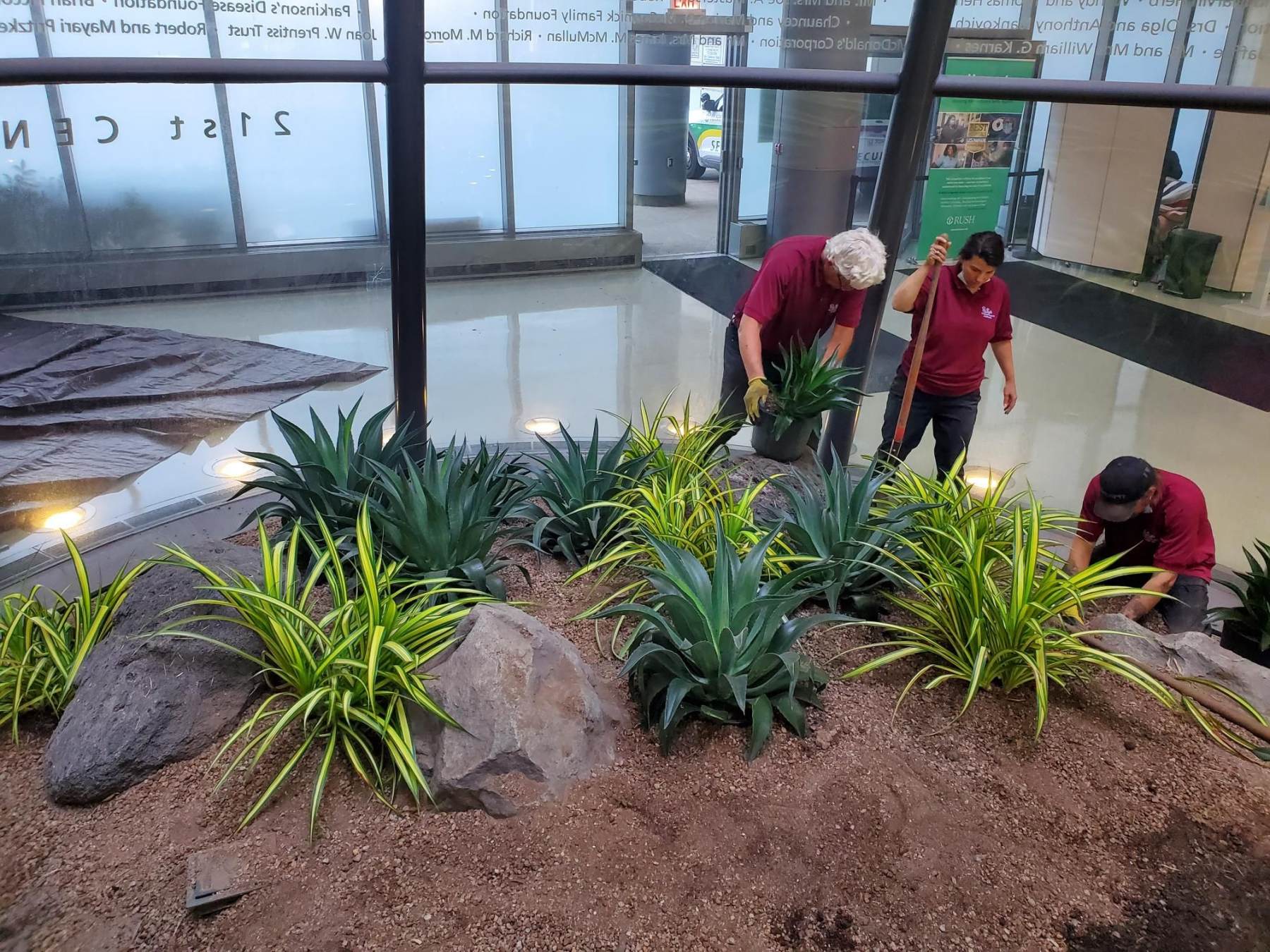
Our Installation team plants the Green Lurida Agave on the desert side of the terrarium. As individual employees we have different titles, but when it comes to installations there is only one title that matters: team. We are all willing to get our hands dirty and pitch in where needed. Clients notice how well we work together and often comment that our installations are efficiently completed with minimal disruption to their business operations. We take that as a great compliment!
THE ARCHITECTURE
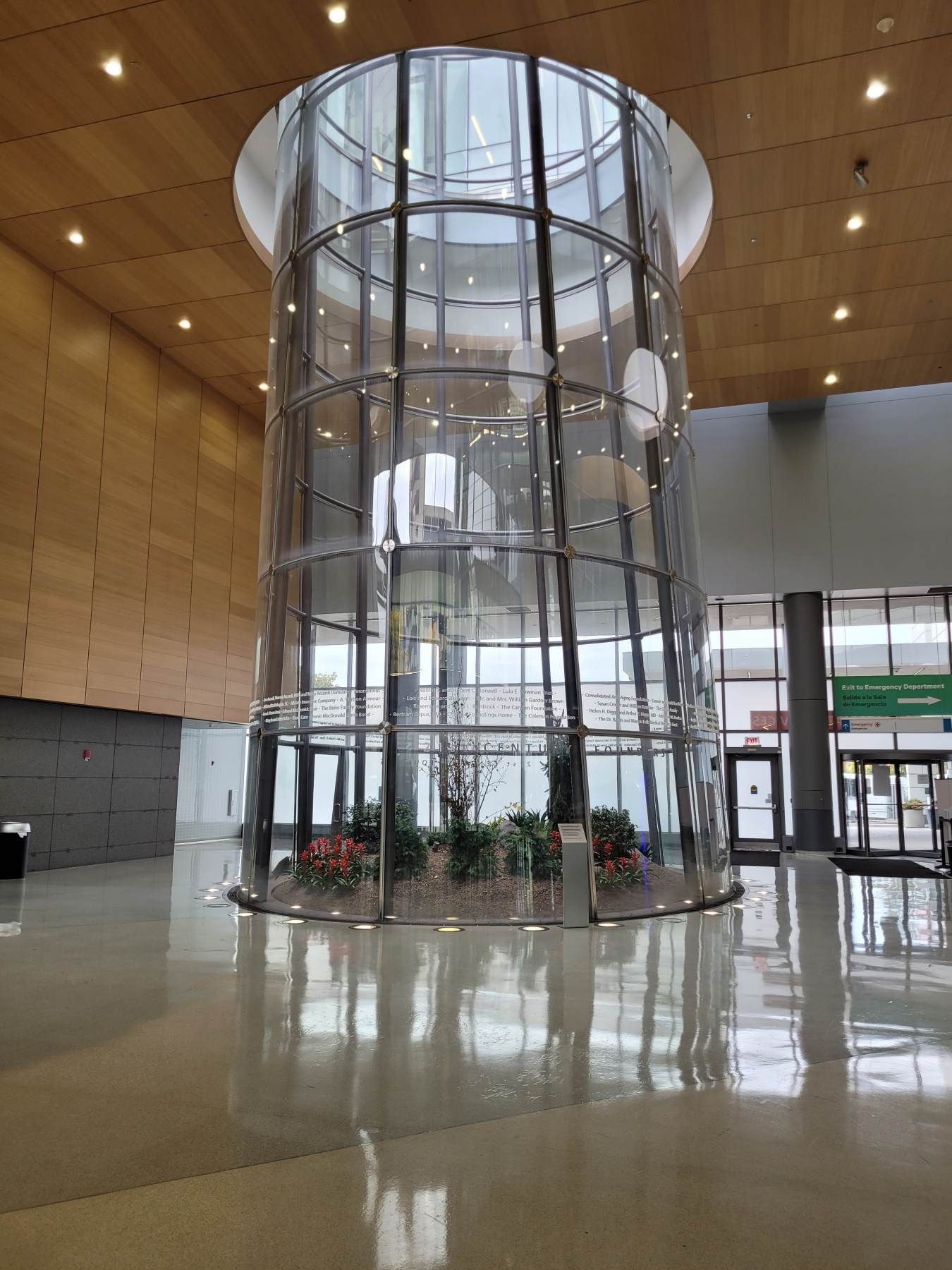
This is a view from the interior lobby looking at the three-story open-air terrarium. The terrarium is located in the medical facility’s main point of entry which connects a newer tower to the original building. The terrarium is oval in shape, 29’L x 21’W and stands 34’tall. The terrarium then projects through the ceiling/roof above the rooftop garden. Laminated low iron glass was used to allow for increased light transparency.
Due to the open-air nature of the terrarium and its year-round exposure to the extreme Chicago weather conditions, the topography was designed to create two distinct mini-climates to host various plant materials. The terrarium’s ground is slanted to create a desert side while the other side stays more temperate.
WORKING SMART AND GIVING BACK
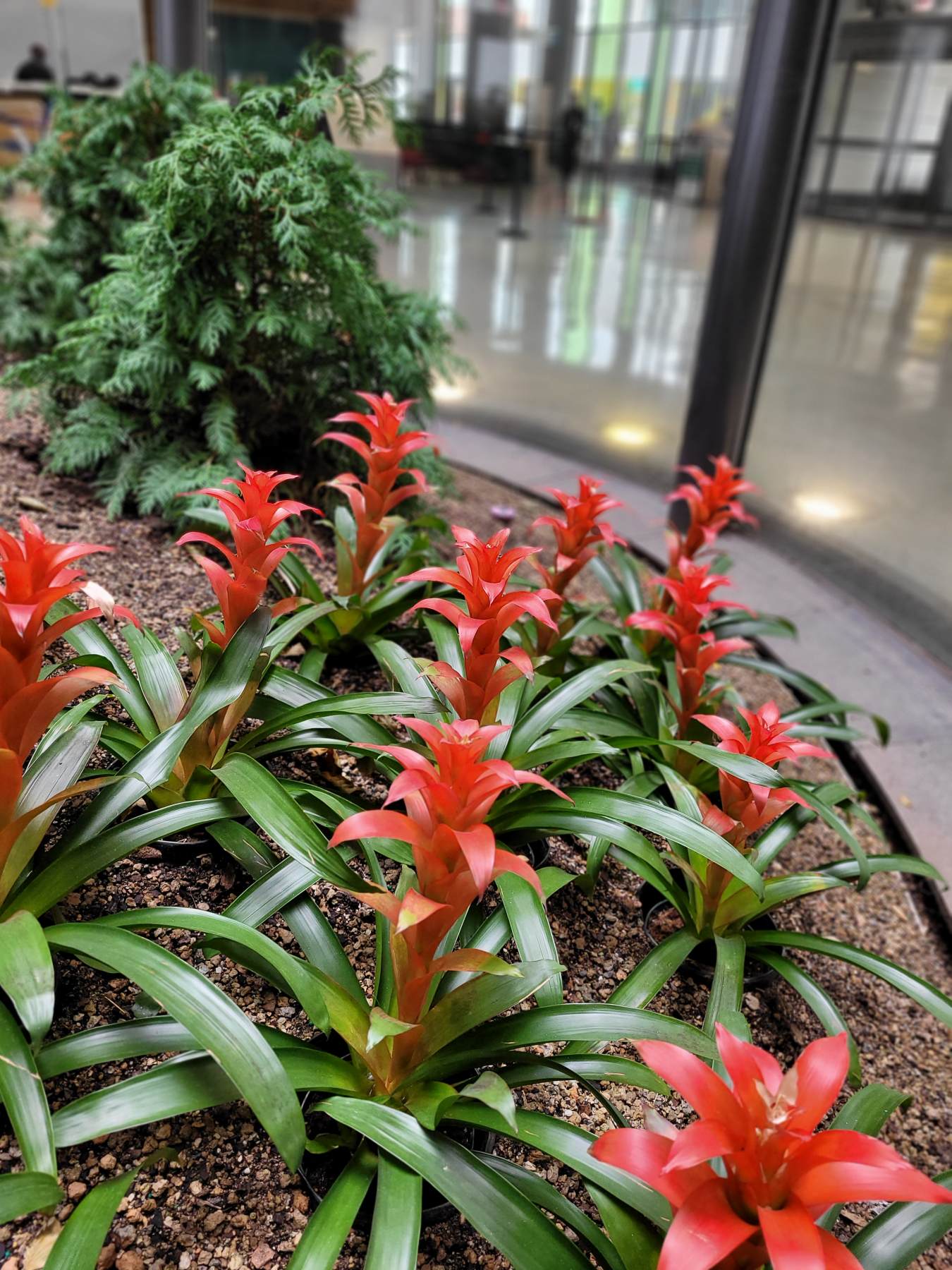
Red Guzmania Bromeliads feature in our blooming rotation program. There are 36 Bloom and Bromeliad rotations throughout the terrarium. They are changed out every two, three, five, or seven weeks depending on the flower type. We discontinue Bloom and Bromeliad rotations in the colder months as the open-air nature of the terrarium would not allow them to thrive.
As big fans of the work smarter not harder approach, we sank slightly larger grow pots into the ground for the blooming rotations. That allows us not to have to direct plant new Blooms with each rotation. Since different Blooms require different amounts of water, our Horticulture Technician tailors watering amounts to the current Bloom being installed or maintained. The grow pots also allow Blooms and Bromeliads to stay warmer during the cooler days of spring and fall.
Clients often wonder what happens to Blooms and Bromeliads that are rotated out from their sites or what happens when we replace a plant due to it not looking its best. This is a question we love to answer. As a green company that has served Chicagoland since 1923, we take a philanthropic, community-oriented approach to rehoming old plants and Blooms.
One such way we give old plants new life is through our “Retired Office Plant Program.” We have a lengthy, ongoing relationship with Brookfield Zoo/Chicago Zoological Society. We regularly donate plants and Blooms that have seen greener days for inclusion in exhibits and animal habitats. It is our team’s privilege to support Brookfield’s/CZS’s mission of inspiring conservation leadership by engaging people and communities with wildlife and nature.
The client whose work we are submitting stated that a major reason they selected our bid was because of our green practices and community-oriented, philanthropic endeavors.
A ONE-OF-A-KIND ENVIRONMENT
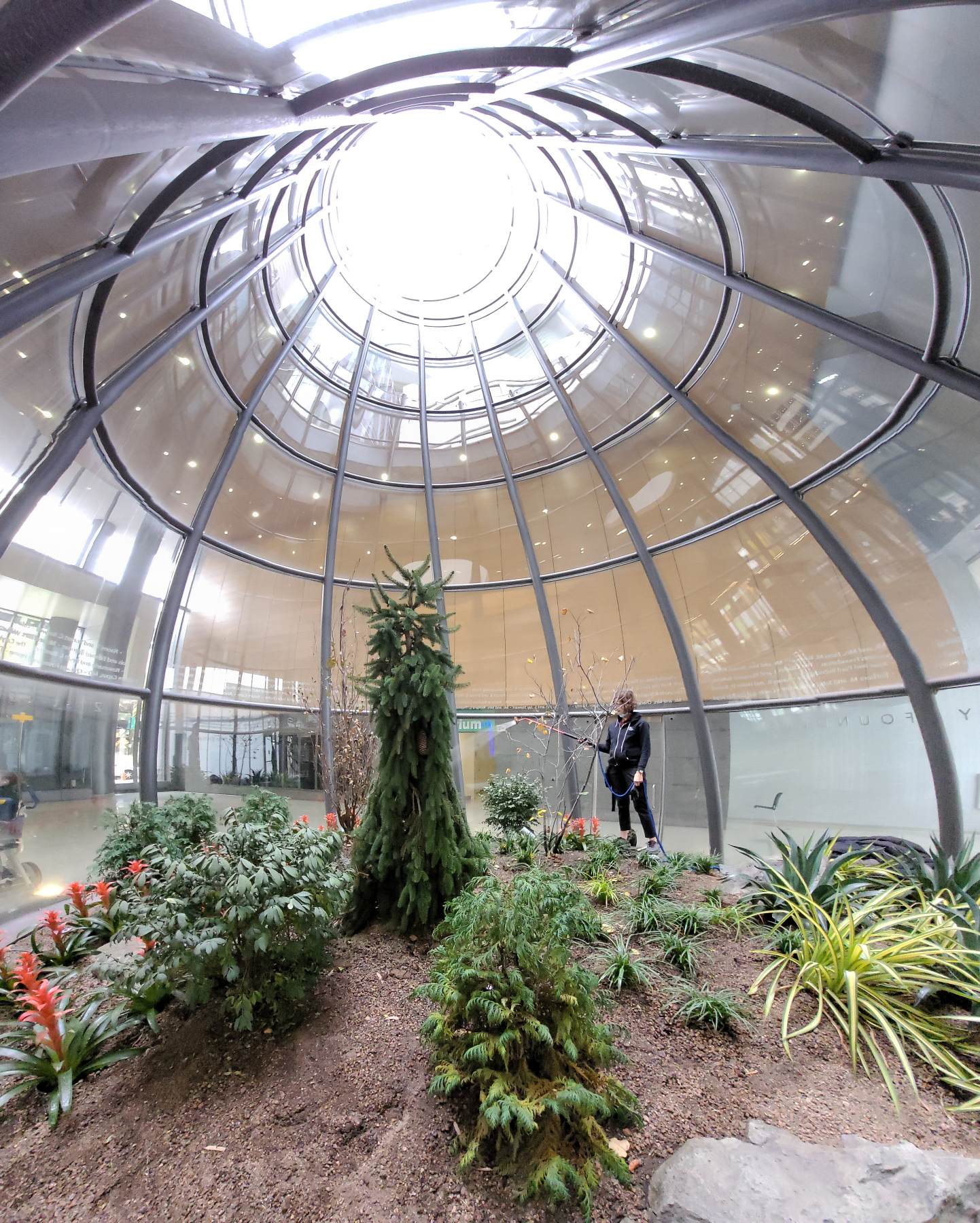
The terrarium is open to the sky above. A Horticulture Technician dressed in layers is watering the plant materials. To get the plants established we are watering once a week. The main tree in this image is the Picea omorika ‘Bruns Pendula’ Serbian Spruce. This is a weeping variety. Other plants in this image are: Euonumus alatus ‘Compactus’ Dwarf Winged Euonymus or Dwarf Burning Bush, Chamaecyparis pisifera ‘Soft Serve’ Japanese False Cypress, Liriope spicata Creeping Lilyturf, Red Guzmania Bromeliads, Pandanus baptistii. Because the Blooms and Bromeliads would not survive Chicago winters they are removed from the terrarium in late October. Blooms and Bromeliads are returned to the installation when we begin to see more moderate temperatures in late April.
ESTABLISHING ROOTS
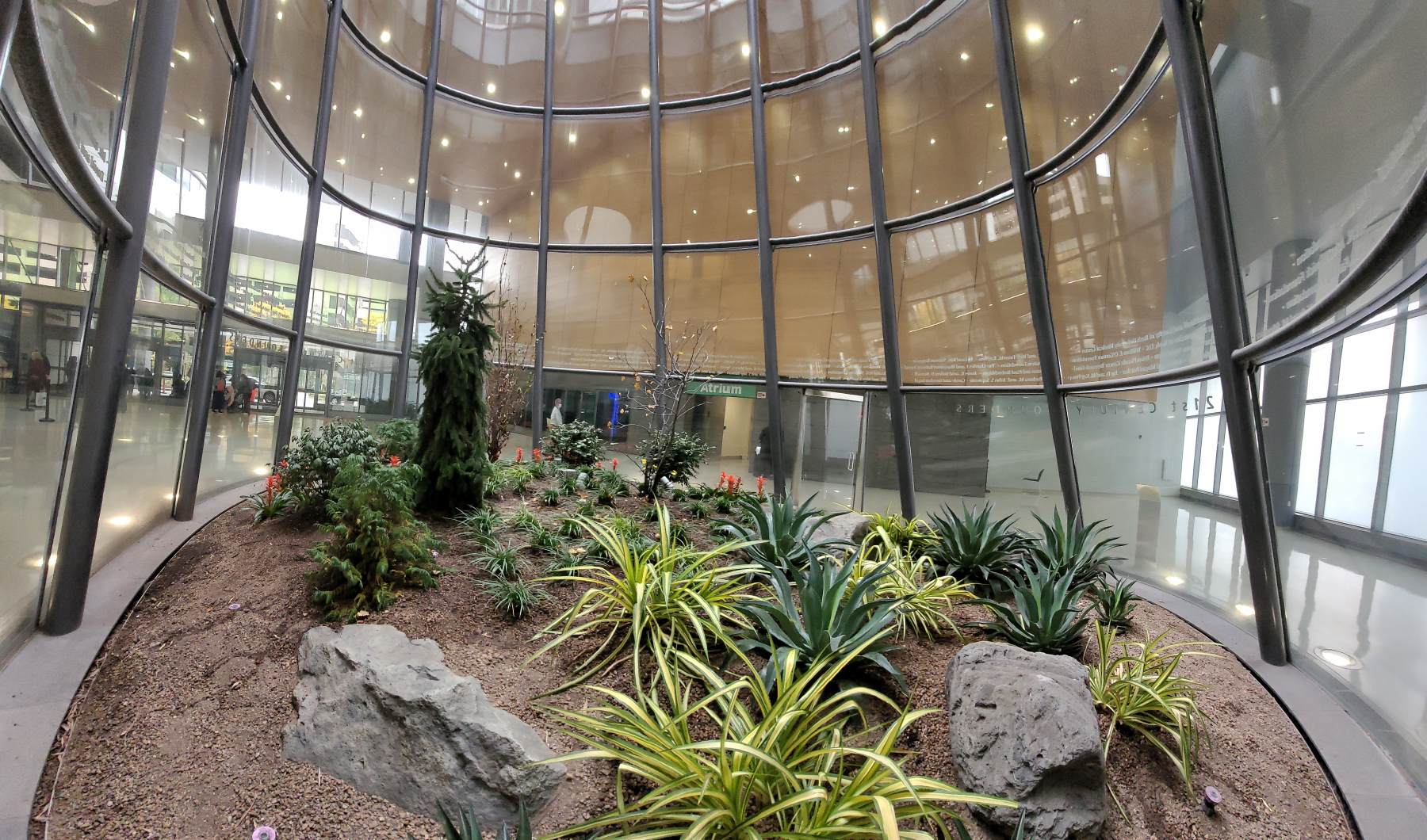
Looking south you can see how the ground is domed in shape. Plant materials are Picea omorika ‘Bruns Pendula’ Serbian Spruce, Euonumus alatus ‘Compactus’ Dwarf Winged Euonymus or Dwarf Burning Bush, Chamaecyparis pisifera ‘Soft Serve’ Japanese False Cypress, Liriope spicata Creeping Lilyturf, Fagus sylvatica ‘Dawyckii Purple’ Dawyck Purple Upright European Beech, Red Guzmania Bromeliads, Pandanus baptistii, and Green Lurida Agave.
The terrarium has an open roof. It was a bold design choice by the architects to create an environment for live and thriving year-round landscaping susceptible to Chicago’s elements, but the decision has paid off in spades for patients, visitors, and employees. The stunning, comfortable climate-controlled connection with nature is located in a setting where the mental health and other benefits of Biophilic Design are passively received.
To establish the plants initially, we have implemented a once weekly watering schedule. The main tree in the above image is a weeping Picea omorika ‘Bruns Pendula’ Serbian Spruce. The 24” root ball was a challenge to get through the 36” doorway and up the hillside of the ground. The entire floor/ground is a dome shape so when you walk in you have to walk up a hill. Fortunately, we have a seasoned team capable of overcoming just about any challenge a site throws our way!
The other plants in the image were delivered and installed with less fanfare: Euonumus alatus ‘Compactus’ Dwarf Winged Euonymus or Dwarf Burning Bush, Chamaecyparis pisifera ‘Soft Serve’ Japanese False Cypress, Liriope spicata Creeping Lilyturf, Red Guzmania Bromeliads, and Pandanus baptistii.
REFLECTING THE SEASONS
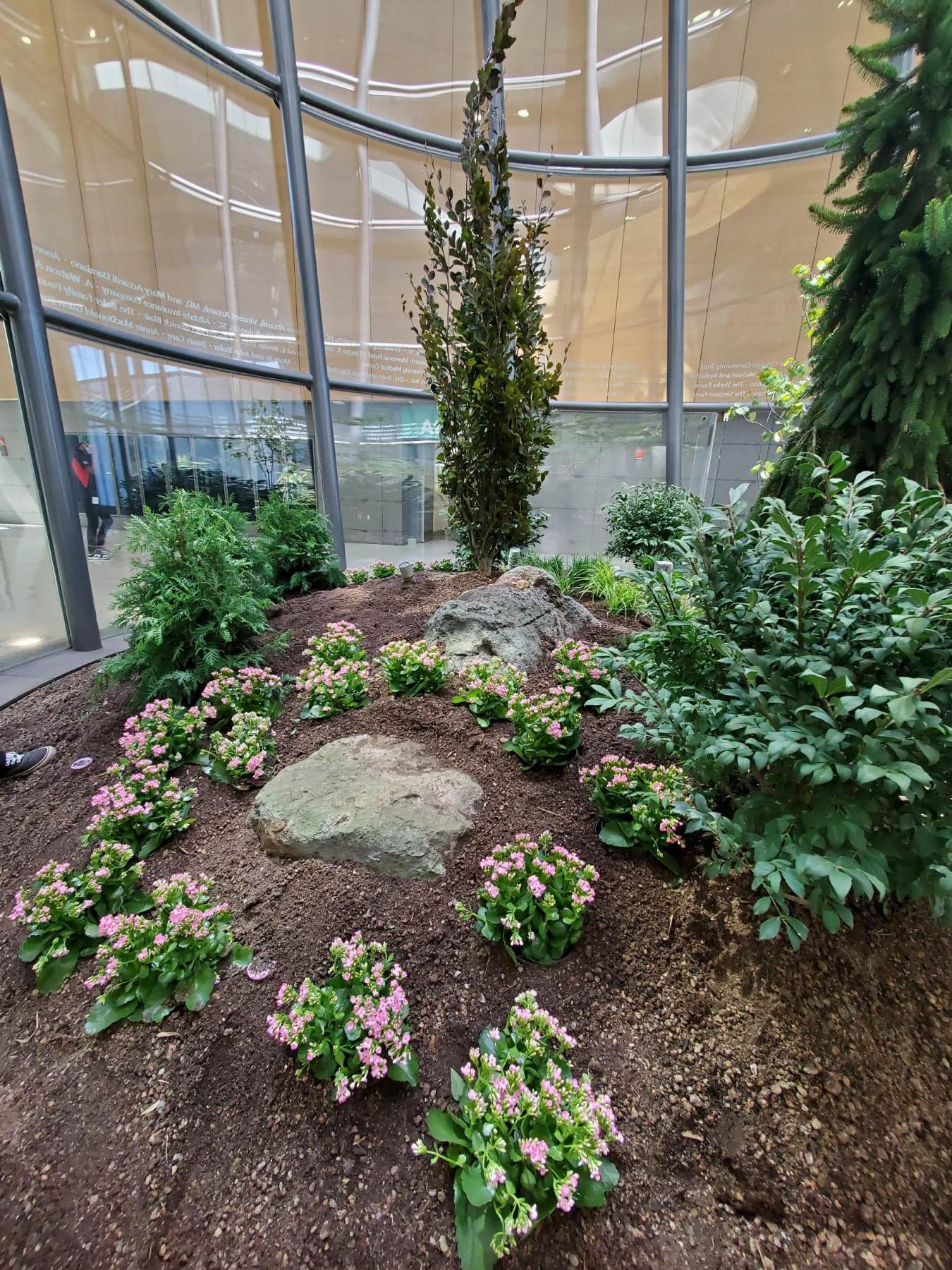
Standing tall and proud in the back is the Fagus sylvatica ‘Dawyckii Purple’ Dawyck Purple Upright European Beech. The front features Pink Kalanchoe part of the blooming rotation program. The Blooming and Bromeliad rotations occur late April through late October. There are no rotations placed during the colder months, as there is no way for them to survive our occasionally brutal Chicago winters.
ROOFTOP GREEN SPACE WITH A BONUS
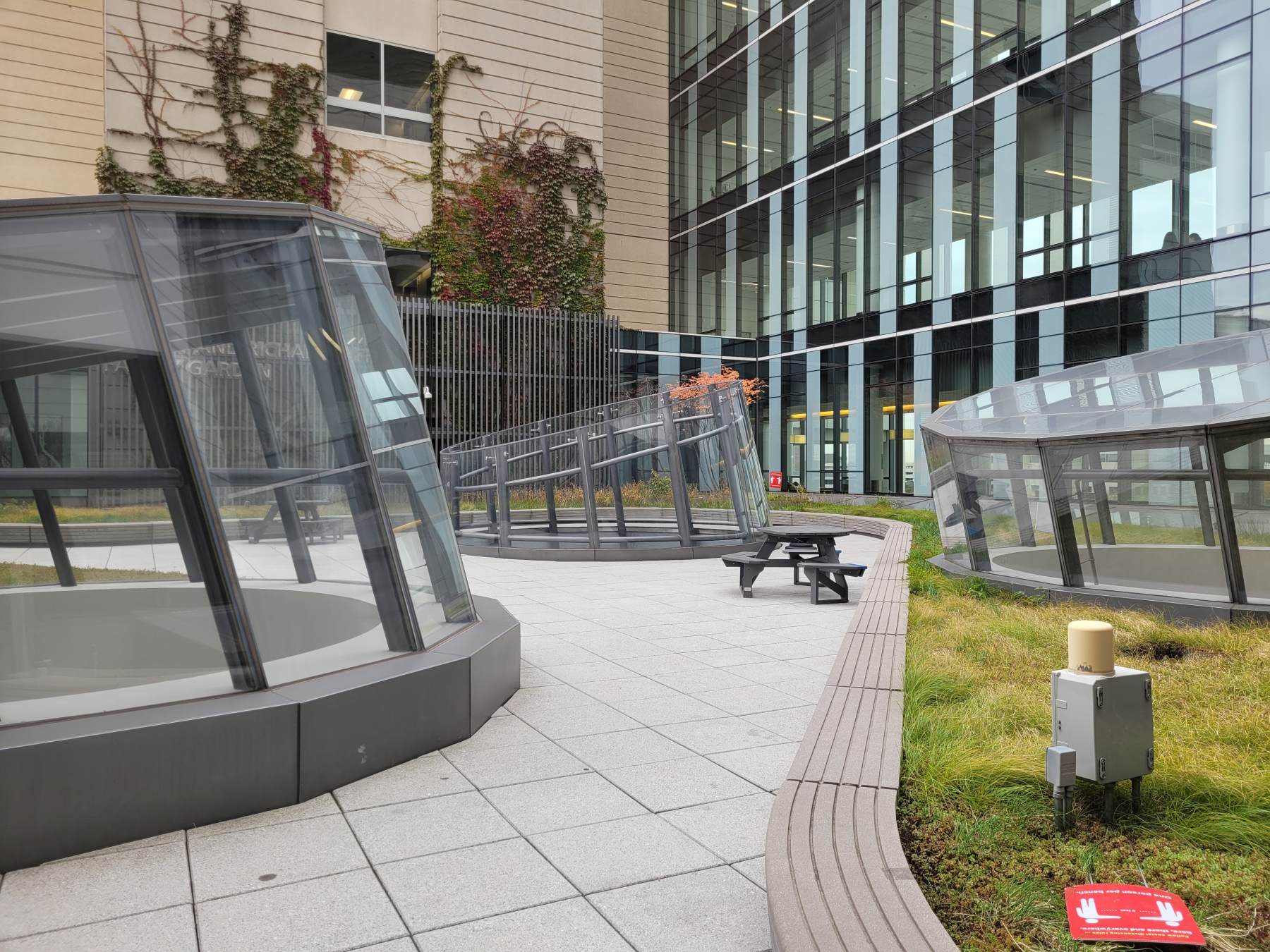
In addition to the open-air terrarium, the rooftop space on the structure’s fourth level features two additional skylights that terminate in the lobby. The rooftop space allows visitors and employees access to a bird’s eye view of the plantings below.
A VIEW FROM THE TOP
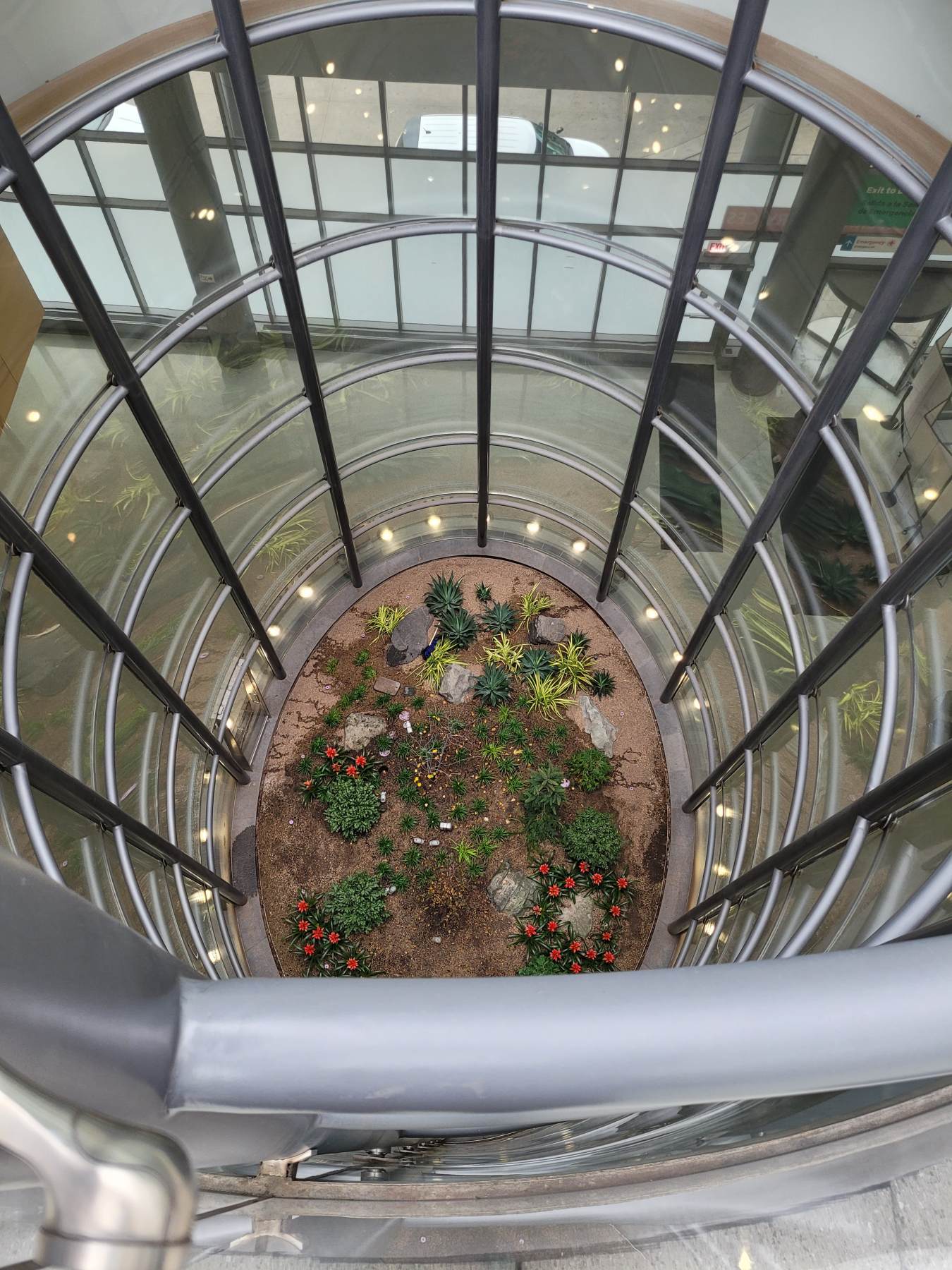
The terrarium garden is shown from the rooftop space above. Regardless of distance or viewing angle, the colors and textural elements of the design can be appreciated.
IN THE SUNLIGHT
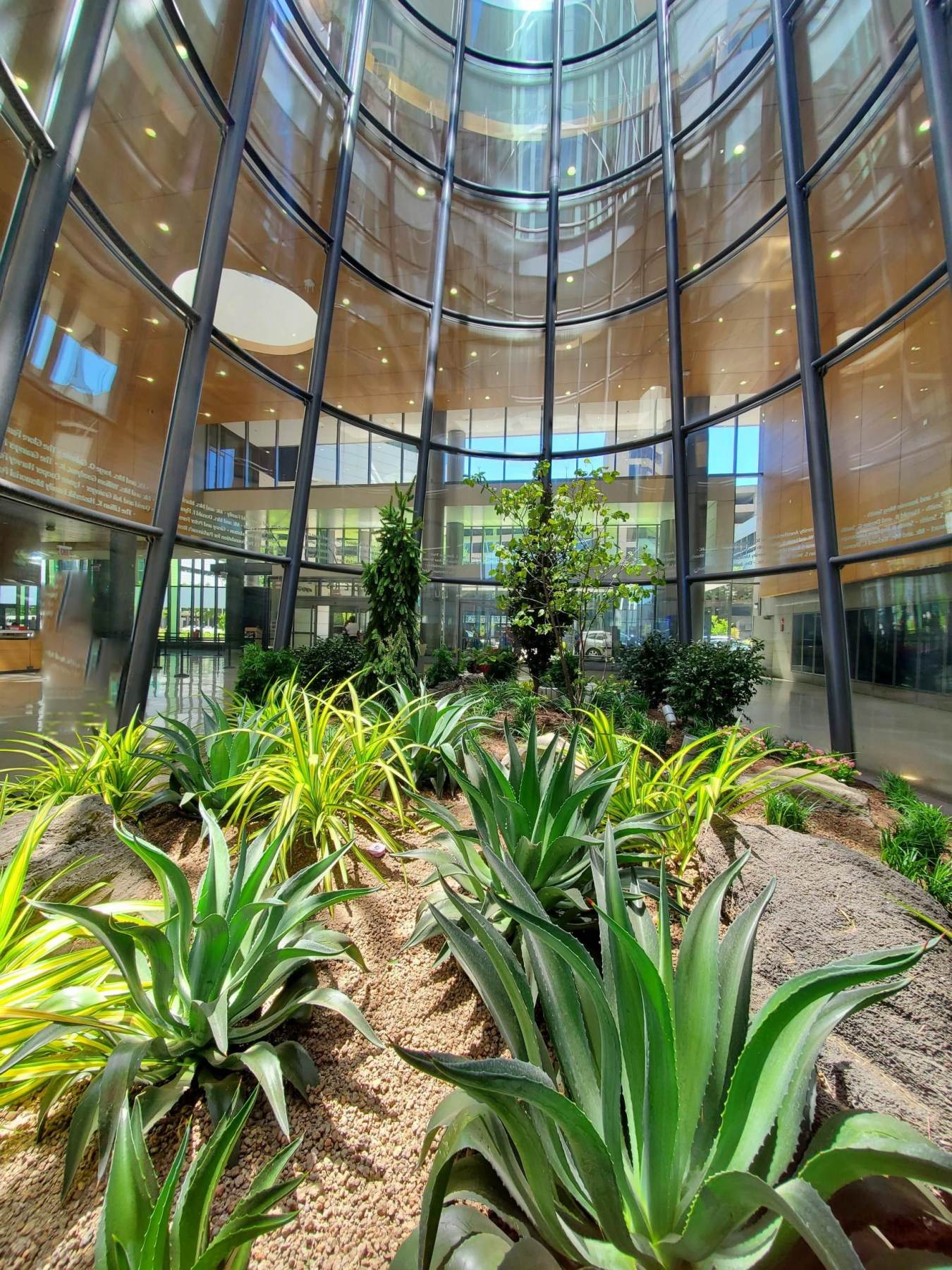
One side of the terrarium is slanted, creating a desert side, while the other side stays more temperate. The topography of the environment was specifically designed to accommodate the open-air nature of the terrarium and its year-round exposure to the extreme Chicago weather conditions.
Above sunlight dapples the 10” Pandanus baptistii, 10” Green Lurida Agave, and 14” Green Lurida Agave in the desert region of the terrarium. The Cercis canadensis Eastern Redbud leaves turn yellow as fall approaches. In some of the other images, the leaves have already fallen off. The image’s background shows one of the additional skylights in the space.
